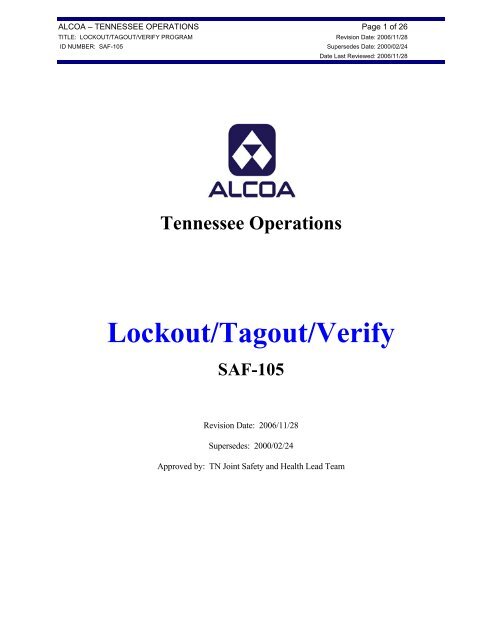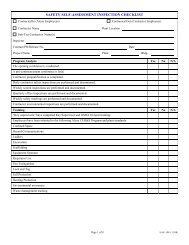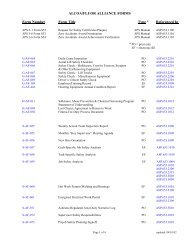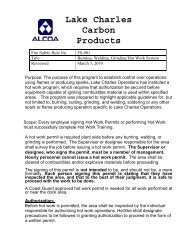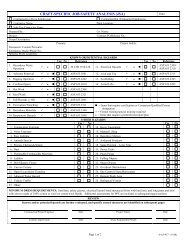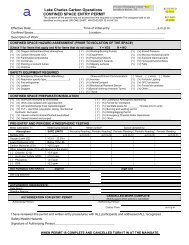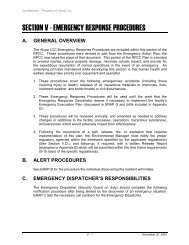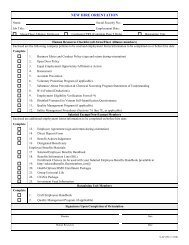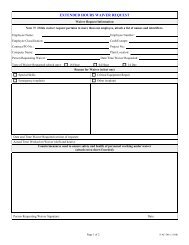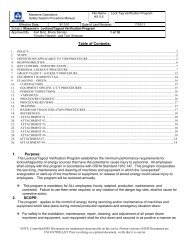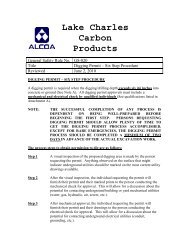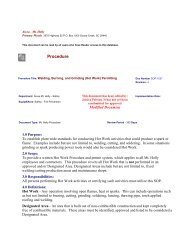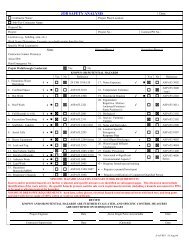Lockout/Tagout/Verification procedure.
Lockout/Tagout/Verification procedure.
Lockout/Tagout/Verification procedure.
Create successful ePaper yourself
Turn your PDF publications into a flip-book with our unique Google optimized e-Paper software.
ALCOA – TENNESSEE OPERATIONS Page 1 of 26TITLE: LOCKOUT/TAGOUT/VERIFY PROGRAM Revision Date: 2006/11/28ID NUMBER: SAF-105 Supersedes Date: 2000/02/24Date Last Reviewed: 2006/11/28Tennessee Operations<strong>Lockout</strong>/<strong>Tagout</strong>/VerifySAF-105Revision Date: 2006/11/28Supersedes: 2000/02/24Approved by: TN Joint Safety and Health Lead Team
ALCOA – TENNESSEE OPERATIONS Page 2 of 26TITLE: LOCKOUT/TAGOUT/VERIFY PROGRAM Revision Date: 2006/11/28ID NUMBER: SAF-105 Supersedes Date: 2000/02/24Date Last Reviewed: 2006/11/28Table of ContentsPurpose.............................................................................................................................3Responsibility...................................................................................................................3A. Energy Control Devices .........................................................................................4LOCKS.........................................................................................................................5OTHER LOCKOUT DEVICES .....................................................................................5TAGS ...........................................................................................................................5B. Energy Control Procedures ...................................................................................10<strong>Lockout</strong> .....................................................................................................................10Release from <strong>Lockout</strong>..............................................................................................12Group <strong>Lockout</strong> Procedures.....................................................................................13Extended Shutdown.................................................................................................14TAG-ONLY Guidelines .............................................................................................16HOT TAP GUIDELINES.............................................................................................17BLUE FLAG and RAILROAD DERAILER Procedures............................................17C. Special Lock/ Tag Removal Procedures...............................................................18D. Flagging Procedures ..............................................................................................19E. Definitions ...............................................................................................................21F. Training Requirements ...........................................................................................24
ALCOA – TENNESSEE OPERATIONS Page 3 of 26TITLE: LOCKOUT/TAGOUT/VERIFY PROGRAM Revision Date: 2006/11/28ID NUMBER: SAF-105 Supersedes Date: 2000/02/24Date Last Reviewed: 2006/11/28PurposeThis program establishes requirements for the lockout / tagout / verification of energyisolation. It must be used to ensure that the machine or equipment is isolated from allpotentially hazardous energy sources (see definition). Before employees perform anyservicing or maintenance activities where unexpected energization, start-up or release ofenergy could cause injury, the equipment must be locked out, tagged out, and verified.<strong>Lockout</strong> / tagout / verification <strong>procedure</strong>s must be considered as being among the mostimportant safety control measures at Tennessee Operations. Failure of any employees tofollow these <strong>procedure</strong>s shall be considered a major and serious infraction of safetypolicy and can result in disciplinary action. <strong>Lockout</strong> / tagout / verification <strong>procedure</strong>sapply to all employees of Tennessee Operations. Contractors' rules must meet orexceed these <strong>procedure</strong>s.Tennessee Operations shall provide training to ensure that the purpose and function ofthe energy control program are understood by employees and that the knowledge andskills required for the safe application, usage, and removal of the energy controls areacquired by employees.The Tennessee Operations’ Safety and Health Department is responsible for theimplementation of a review and revision process for this program. This entire programmust be reviewed, at least annually, to ensure continuous and effective compliance withall applicable codes and regulations.ResponsibilityA. Departmental responsibilities:• Training personnel in the recognition, evaluation and control of the sources ofhazardous energy within the department.• Develop, document and maintain lockout/ tagout/ verification <strong>procedure</strong>s forall energy sources identified on each piece of equipment or machinery.• Maintain a continuous tracking system for proper use of Equipment DangerTags.• Furnishing locks, tags, chains, wedges, pins, etc. for isolation, securing,blocking, and controlling release of energy.• Implement the <strong>Lockout</strong>/ <strong>Tagout</strong>/ <strong>Verification</strong> Program.• Audit lockout/ tagout/ verification <strong>procedure</strong>s.
ALCOA – TENNESSEE OPERATIONS Page 4 of 26TITLE: LOCKOUT/TAGOUT/VERIFY PROGRAM Revision Date: 2006/11/28ID NUMBER: SAF-105 Supersedes Date: 2000/02/24Date Last Reviewed: 2006/11/28⇒ External audits⇒ Internal audits∗ includes the completion of the <strong>Lockout</strong>/ <strong>Tagout</strong>/ <strong>Verification</strong>Checklist SAF-211 and develop a tracking system to insurecorrections are implemented.• Shall certify annually that (3) periodic inspections have been performed, perSAF-211, for each of the five <strong>procedure</strong>s (Tag Only, Personal <strong>Lockout</strong>,Group <strong>Lockout</strong>, Extended Shutdown, and Blue Flag), if applicable, in eachArea.• Establish Engineering and Maintenance practices which insure that lockableenergy isolation devices, standardized device nomenclature andidentification, accurate drawings, and written safe <strong>procedure</strong>s are integralfunctions within each department.• Involve appropriate employees in the planning for large scale shutdowns toinclude review of energy control <strong>procedure</strong>s, tasks to be performed, availabledrawings, and any other pertinent information to the scope of work.• When feasible, simplify lockout / tagout / verification <strong>procedure</strong>s for complexequipment and processes by utilizing effective engineering design andmaintenance.B. The employee(s) involvement:• Question all aspects of the job, expected or unexpected, during theevaluation phase of a job.• Evaluate the potential for hazardous energy contact or exposure, the needfor additional personal protection, and other safety precautions beforebeginning work of any kind.• Inspect and test all safety equipment before use. Assure that any prescribedinspection by others is current, and inspect before use, as required.• Participate in a group review of safety instructions for correct interpretationon major jobs or jobs where specific concerns exist. Check with supervisor,project engineer, task coordinator, or leader if questions remain.• Stop work immediately and resolve unusual or unexpected situations at themoment they arise.A. Energy Control DevicesAn ENERGY ISOLATION DEVICE is a mechanical device that physically preventsthe transmission or release of energy. These devices are secured by locks, tagsand other hardware to ensure a zero energy state during servicing and maintenance
ALCOA – TENNESSEE OPERATIONS Page 5 of 26TITLE: LOCKOUT/TAGOUT/VERIFY PROGRAM Revision Date: 2006/11/28ID NUMBER: SAF-105 Supersedes Date: 2000/02/24Date Last Reviewed: 2006/11/28activities. Push buttons, E-stops, toggle switches, etc. may not be used asisolation devices for lockout purposes.LOCKSThe padlock approved for use at Tennessee Operations is a red lock. These locksmay be obtained through Plant Protection. This is the only lock that may be usedfor lockout / tagout / verification and shall not be used for other purposes (i.e.toolboxes, lockers, etc.).ALCOASAFETYLOCKOTHER LOCKOUT DEVICESOther lockout devices used in conjunction with locks and tags are chains, wedges,key blocks, adapter pins, self-locking fasteners, circuit breaker locking devices, orother hardware for isolating, securing, or blocking of machines or equipment fromenergy sources.TAGSA. Personal Danger Tag - is used at Tennessee Operations for personalprotection.B. Extended Shutdown Tag - is used for group lockout and extended shutdownsituations.C. Equipment Danger Tag - used to designate equipment/ vehicles in need ofrepair; not to be used for personal protection.NOTES: 1. In certain situations, where special circumstances exist orwhere detailed startup <strong>procedure</strong>s may be necessary toprotect the equipment, use of this tag could be required.2. Upon removal of this tag and equipment return to service,additional communication may be needed.3. When dealing with mobile equipment or vehicles, refer to theMobile Equipment program.D. Information Tag - used only to provide additional information.
ALCOA – TENNESSEE OPERATIONS Page 6 of 26TITLE: LOCKOUT/TAGOUT/VERIFY PROGRAM Revision Date: 2006/11/28ID NUMBER: SAF-105 Supersedes Date: 2000/02/24Date Last Reviewed: 2006/11/28TAGS (cont.)Personal Danger TagsSigned ByDANGERWORKin progressDO NOTOPERATEDANGERDANGERDO NOT OPERATEOR REMOVE THISTAG.ANYONE DOINGSO WITHOUTAUTHORITY ISSUBJECT TODISCIPLINARYACTION.Dept.DateSEE OTHER SIDES/N 991-708-02501. Used to provide individual personal protection; each employee is responsiblefor the placement and removal of his/her own lock and tag.2. Used in conjunction with a lock every time an individual performs a lockout.3. Must be dated and signed at the time it is applied. Employee’s name needsto be legible.4. Attached to the lock by inserting the lock shank through the eye of the tag.5. The personal lock and tag must be removed when the task is completed or atthe end of their respective shift, whichever comes first.Note 1:Note 2:In some cases equipment will not be physically capable of accepting alock. In such instances the TAG-ONLY guidelines shall apply. (See pages22, 23)In some cases, equipment may be considered lockable. However, ifplacement of a lock poses danger to the individual placing the lock, thenthe TAG-ONLY guidelines shall apply.
ALCOA – TENNESSEE OPERATIONS Page 7 of 26TITLE: LOCKOUT/TAGOUT/VERIFY PROGRAM Revision Date: 2006/11/28ID NUMBER: SAF-105 Supersedes Date: 2000/02/24Date Last Reviewed: 2006/11/28TAGS (cont.)Extended Shutdown TagsDANGEREXTENDEDSHUTDOWNWORK INPROGRESSDO NOTOPERATEDANGEREXTENDEDSHUTDOWNWORK INPROGRESSDO NOTOPERATESigned ByDept.Date1. Applied and removed by primary authorized employee ONLY.2. Dated and signed at the time it is applied.3. Used for group lockout situations.4. Used for extended/ multiple shift work.5. Shall not be used for individual personal protection.
ALCOA – TENNESSEE OPERATIONS Page 8 of 26TITLE: LOCKOUT/TAGOUT/VERIFY PROGRAM Revision Date: 2006/11/28ID NUMBER: SAF-105 Supersedes Date: 2000/02/24Date Last Reviewed: 2006/11/28TAGS (cont.)Equipment Danger TagALUMINUMCOMPANY OFAMERICATAG NO. 74931 DATEWARNINGTHIS TAG HAS BEEN ATTACHED BECAUSE(Write reason in space below)NameDept.DO NOT USE, MOVE OR OPERATE WHILETHIS TAG IS ATTACHEDTag Attached ByNo.ALUMINUMCOMPANY OFAMERICAWARNINGDO NOT USE, MOVE OR OPERATE WHILETHIS TAG IS ATTACHEDDO NOT DETACH UNTIL REPAIRS HAVE BEENCOMPLETED.This Equipment Ready for Service and TagRemoved ByNameDept.No.DateTAG No.680499 DATEHas been attached toBecausePROTECT YOUR FELLOW WORKERUSE THIS STUB INACCORDANCE WITH SAFETYRULES.SignedNo.1. Designates equipment in need of repair. ( See “Notes” on page 7 )2. Placed on energy isolation devices to prevent operation (main switch, valve,vehicles, etc.)3. The person initiating the tag sends the stub to his/ her supervisor.4. Tag is removed and filled out by qualified individual(s), responsible for completingrepairs and/ or returning equipment to service, and sent to the originatingdepartment.5. This tag is NEVER used for personal protection.Note: Wire Ties must be used to attach the Equipment Danger Tag to the isolationdevice.
ALCOA – TENNESSEE OPERATIONS Page 9 of 26TITLE: LOCKOUT/TAGOUT/VERIFY PROGRAM Revision Date: 2006/11/28ID NUMBER: SAF-105 Supersedes Date: 2000/02/24Date Last Reviewed: 2006/11/28TAGS (cont.)Information TagALCOATENNESSEE OPERATIONSINFORMATIONTAG:T-731 991-707-31001. This tag is NEVER used for Personal or Equipment protection.2. It is only used to provide additional information.3. It may be used to clarify and provide details about any given situation such asbarricading or flagging.Note: Wire Ties are strongly recommended for attachment of the InformationTag, especially in outdoor or corrosive environments. When applied withanother tag and a lock, this tag may be attached by passing the lockshank through the eye of the tag.
ALCOA – TENNESSEE OPERATIONS Page 10 of 26TITLE: LOCKOUT/TAGOUT/VERIFY PROGRAM Revision Date: 2006/11/28ID NUMBER: SAF-105 Supersedes Date: 2000/02/24Date Last Reviewed: 2006/11/28B. Energy Control Procedures<strong>Lockout</strong>1. Preparation for Shutdown2. Shutdown3. Isolation• When appropriate, review proposed work with supervisor in charge ofequipment or facility and reach agreement on potential operatinginterference. If an immediate shutdown is required to protectemployees or equipment, use necessary emergency shutdown<strong>procedure</strong>s.• Affected employees, that is, those working in the immediate area ofthe machinery or equipment involved, shall be notified prior toapplication of energy controls.• Use normal stop or shutdown <strong>procedure</strong>s to shutdown equipment(depress stop button, shift lever, operate valve, etc. )QUALIFIED PERSONS SHALL OPERATE ALL DISCONNECT SWITCHES FORLOCKOUT/ TAGOUT PURPOSES, WHEN VISUAL VERIFICATION OF BLADEOPENING AND/ OR VOLTAGE CHECKS ARE REQUIRED.• Operate switch, valve, or other energy isolation device(s) so that theequipment is isolated from its energy source(s).Note 1: Push buttons, E-stops, toggle switches, etc. may not beused as isolation devices for lockout purposes.Note 2: Except for emergency situations, all open faceddisconnects and all switches larger than 60 amps mayonly be operated by electricians or other qualifiedelectrical personnel. No switch should be pulled under aload.• Stored energy must be controlled as necessary to assure zero energystate at all times until work is completed. For example, blockinghydraulic systems, bleeding airlines or blanking steam lines to preventre-accumulation of stored energy.4. Lock and Tag• Lock and tag the isolation device(s) in the safe position.
ALCOA – TENNESSEE OPERATIONS Page 11 of 26TITLE: LOCKOUT/TAGOUT/VERIFY PROGRAM Revision Date: 2006/11/28ID NUMBER: SAF-105 Supersedes Date: 2000/02/24Date Last Reviewed: 2006/11/28• If more than one individual is required to lockout/ tagout/ verifyequipment, each shall place his/ her own personal lock on the energyisolation device. When an energy isolation device cannot acceptmultiple locks and tags, a multiple lockout device such as a gang haspshall be used.• The person responsible for the lockout must maintain control of thekey.5. <strong>Verification</strong>• Prior to starting work on machines or equipment that have beenlocked or tagged out, the authorized employees shall verify thatisolation and de-energization of the machine or equipment have beenaccomplished.• <strong>Verification</strong> shall include all of the appropriate, following practiceswhich are necessary to confirm removal and control of hazardousenergy sources. Additional <strong>procedure</strong>s may be required.⇒ Check the disconnect or switch handle after lockout/ tagout tomake certain it cannot be moved to the "on" position.⇒ Only electricians or other electrically qualified ( 29 CFR1910.399 definitions ) personnel shall perform:∗ <strong>Verification</strong> of blade opening visually, when otherphysical verification <strong>procedure</strong>s are not feasible.Voltage checks, phase-to-phase and phase-to-ground,shall be made, when neither confirmation of bladeopening nor other physical means of verification arepossible.∗ Visual verification of blade opening and testing forvoltage, phase-to-phase and phase-to-ground, is alwaysrequired before beginning any work on electricalconductors or electrically energized parts.⇒ Try the machine “start” controls after lockout/ tagout to makesure that the equipment does not operate. ( Trying machinestart controls MAY NOT be used as the sole means ofverification for: equipment which is fed by larger than a 60Amp. switch; complex processes or equipment withmultiple energy sources; or other equipment for whichwritten <strong>procedure</strong>s require additional means ofverification. )
ALCOA – TENNESSEE OPERATIONS Page 12 of 26TITLE: LOCKOUT/TAGOUT/VERIFY PROGRAM Revision Date: 2006/11/28ID NUMBER: SAF-105 Supersedes Date: 2000/02/24Date Last Reviewed: 2006/11/28⇒ Test and inspect for stored air, gas, steam, hydraulic fluid, etc.,that remains under pressure in piping, accumulators, andcylinders.⇒ Operate enough combinations of controls to insure eliminationof stored energy.⇒ Confirm that energy stored in springs or elevated devices are atzero energy state.⇒ Check for leaking valves.⇒ Confirm that all necessary caps, blanks, or blinds, are in placeand lines containing potential hazardous energy sources aredisconnected.⇒ Determine if system components have been bled or purged.(Lock and Tag bleed valves in the open position.)⇒ Assure that upstream and downstream pressures adjacent tocontrol valves have been relieved.⇒ For plug connected equipment, ascertain that equipment isunplugged and that the plug is under the exclusive control ofthe employee(s) performing service or maintenance.NOTE: RETURN CONTROLS (push buttons, selector switches, valves, levers,etc.) TO NEUTRAL, OFF, OR SAFE POSITION BEFORE BEGINNINGWORK. REMEMBER, THE LAST FUNCTION TRIED MAY OCCURUPON RE-ENERGIZATION.Release from <strong>Lockout</strong>1. Inspect the work area to make sure that nonessential items have beencleared.2. After all tools have been removed from the machine or equipment,guards have been reinstalled and employees are in the clear, remove alllockout/ tagout devices.3. Notify all affected employees in the area that the lockout devices havebeen removed and that the equipment is about to be re-energized.4. In situations where the lockout must be temporarily removed for testing,trouble-shooting, or repositioning, steps 1, 2, and 3 outlined above mustbe followed with the exception of reinstalling guards. After completingthe testing, trouble-shooting, or repositioning, de-energize all systemsand reapply energy control devices. Once the energy control deviceshave been reapplied, the lockout process needs to be re-verified beforeresuming work.
ALCOA – TENNESSEE OPERATIONS Page 13 of 26TITLE: LOCKOUT/TAGOUT/VERIFY PROGRAM Revision Date: 2006/11/28ID NUMBER: SAF-105 Supersedes Date: 2000/02/24Date Last Reviewed: 2006/11/28Group <strong>Lockout</strong> ProceduresWhen a maintenance or service event takes place, planned or unplanned, and alarge number of isolation devices and/ or employees from a crew, craft, department,or other group of personnel are involved, a large number of personal locks would beneeded. It will be more efficient to perform a group lockout <strong>procedure</strong> using alockbox. Group lockout <strong>procedure</strong>s shall afford employees a level of protectionequivalent to that provided by individual implementation of personal lockout andtagout devices.• A primary authorized person shall initiate the Authorization Letter &Authorization Letter and Transfer Log and place a departmental lock anda signed extended shutdown tag on each energy isolation device after deenergization.The Authorization Letter and Transfer Log shall be used tospecify isolation points, if a separate list is not available.• The primary authorized employee shall follow the verification <strong>procedure</strong>sto insure the removal or control of hazardous energy sources.• The primary authorized employee places the key(s) to the departmentallocks in the lockbox, and then locks the box with another separatelykeyed departmental lock and an extended shutdown tag. The key to thislock may then be transferred as necessary. The Authorization Letter andTransfer Log, which remains with the lockbox, shall be used for thispurpose. Only one individual may have control of the key at any time. Attime of transfer, the new primary authorized employee shall employ allnecessary means to assure continuity of protection. This does not relieveindividual responsibilities for some form of verification as it pertains totheir personal safety.• A list of isolation points shall also remain with the lockbox.• Each employee assigned to the job affixes his or her own personal lockand tag to the lockbox.• Each authorized employee, affixing a personal lock and danger tag, shallverify that the equipment to be serviced and all associated hazardousenergy has been rendered safe. As a minimum, the employee mustreview the lockout/ tagout process with the primary authorized employee.CAUTION: That part of verification which involves “ONLY” visualinspection of lockout devices may be done withemployees in the work area.WARNING: Operation of controls for verification purposes requiresthat the work area is to be clear of all employees.Note 1: Anyone not part of the original group who wishes to work in the areaisolated by a group lockout <strong>procedure</strong> must contact the primaryauthorized employee and review the lockout/ tagout/ verification process
ALCOA – TENNESSEE OPERATIONS Page 14 of 26TITLE: LOCKOUT/TAGOUT/VERIFY PROGRAM Revision Date: 2006/11/28ID NUMBER: SAF-105 Supersedes Date: 2000/02/24Date Last Reviewed: 2006/11/28before placing a personal lock and tag on the lockbox and proceedingwith servicing or maintenance.Note 2: In situations where the lockout must be temporarily removed for testing,trouble-shooting, or repositioning, refer to “Release From <strong>Lockout</strong>” page16.Extended ShutdownWhen work on equipment is projected to extend for more than one shift and mayinvolve multiple energy sources or many employees, an Extended Shutdownlockout/ tagout/ verification <strong>procedure</strong> should be used.1. The “Initial Primary Authorized Employee” is accountable fordetermination of isolation points and safe shutdown/ startup <strong>procedure</strong>s.He/ she shall provide a departmental lock(s) with a signed ExtendedShutdown Tag(s) for each isolation device and the lockbox, and shallinitiate the Authorization Letter and Transfer Log SAF-212. Theresponsibility for de-energization followed by actual placement ofdepartmental locks and Extended Shutdown Tags may be held by thesecond level supervisor or be transferred to another qualified supervisor,along with Extended Shutdown responsibility, on the Authorization Letterand Transfer Log. Responsibility for the Extended Shutdown may thenbe transferred to the next primary authorized employee, as necessary,utilizing the Authorization Letter and Transfer Log, which remains withthe lockbox, along with the list of isolation points. The AuthorizationLetter and Transfer Log shall be used to specify isolation points, if aseparate list is not available. Only one primary authorized employee isallowed at any given time. The person responsible for the lockout mustmaintain control of the key.2. The current primary authorized employee places the key(s) to thedepartment locks in the lockbox, and then locks the box with anotherseparately keyed departmental lock and an extended shutdown tag. Thekey to this lock may then be transferred, as necessary, for as long asthere is an extended shutdown. The Authorization Letter and TransferLog shall be used for this purpose. Only one individual may have controlof the key at any time. At time of transfer, the new primary authorizedemployee shall employ all necessary means to assure continuity ofprotection. This does not relieve individual responsibilities for some formof verification as it pertains to their personal safety.
ALCOA – TENNESSEE OPERATIONS Page 15 of 26TITLE: LOCKOUT/TAGOUT/VERIFY PROGRAM Revision Date: 2006/11/28ID NUMBER: SAF-105 Supersedes Date: 2000/02/24Date Last Reviewed: 2006/11/28The following options may be used in conjunction with requirements of paragraphs 1 and 2 above:Option A: If the job involves multiple groups (e.g. contractor) each group will have theirown primary authorized employee that will affix their own departmental locksand tags on the isolation devices and then place the keys in the respectivelockbox for their group.Option B: If the job involves multiple groups, a single primary authorized employee isassigned overall job-associated lockout / tagout / verification responsibilities,including application of departmental locks and tags on the isolation devices, forall persons engaged in or affected by the servicing or maintenance activity.Only one lockbox is used for all authorized employees.Option C: If the job involves multiple shifts and any combination of multiple groups,various shifts, multiple tasks, many individuals or numerous isolation devices, asingle primary authorized employee is assigned as an Outage <strong>Lockout</strong>Coordinator. This individual is responsible for all normal duties associated witha primary authorized employee including placement of departmental locks andextended shutdown tags on all isolation devices. The key(s) to these locksshall be placed in a lockbox which shall be defined as the master lockbox forthis outage. Each group shall have their own primary authorized employee whowill apply a departmental lock and an extended shutdown tag to the masterlock box instead of on individual isolation devices. This key will be placed intheir own group lock box. A second separately keyed departmental lock andextended shutdown tag is applied to this lock box. <strong>Verification</strong> of isolation of allenergy sources must be completed by the group primary authorized employee.Each group’s primary authorized employee shall keep the Outage <strong>Lockout</strong>Coordinator informed of changes in personnel or tasks being performed.Note 1: Anyone not part of the original group who wishes to work in the areaisolated by a group lockout <strong>procedure</strong> must contact the primaryauthorized employee and review the lockout / tagout / verificationprocess before placing a personal lock and tag on the lockbox andproceeding with servicing or maintenance.Note 2: In situations where the lockout must be temporarily removed for testing,trouble-shooting, or repositioning, refer to “Release From <strong>Lockout</strong>”,page 16.3. Each authorized employee assigned to the task places his/ her personaldanger tag and lock on the respective lockbox for his/ her group.4. Each authorized employee, affixing a personal lock and danger tag, shallverify that the equipment to be serviced and all associated hazardous
ALCOA – TENNESSEE OPERATIONS Page 16 of 26TITLE: LOCKOUT/TAGOUT/VERIFY PROGRAM Revision Date: 2006/11/28ID NUMBER: SAF-105 Supersedes Date: 2000/02/24Date Last Reviewed: 2006/11/28energy has been rendered safe. As a minimum, the employee mustreview the lockout/ tagout process with the primary authorized employee.(See definition of “verification” on page 35.)CAUTION: That part of verification which involves “ONLY” visual inspectionof lockout devices may be done with employees in the work area.WARNING: Operation of controls for verification purposes requiresthat the work area is to be clear of all employees.5. Responsibility for an extended shutdown may be transferred from oneprimary authorized employee to another utilizing the Authorization Letterand Transfer Log.6. At shift change or upon completion of an individual’s task, eachemployee shall remove his/ her personal lock and danger tag from thelockbox. All incoming authorized employees shall place their personallocks and danger tags on their group’s respective lockbox. Thedepartmental locks and extended shutdown tags are never removedfrom the energy isolation devices or lockbox at shift change.7. All affected employees in the area shall be notified by the on shiftprimary authorized employee when any of the lockout devices are to beremoved or when any equipment is about to be re-energized.A. Upon completion of the job and after all personal danger locks andtags have been removed from the lockbox, only the current primaryauthorized employee (as determined by the Authorization Letter andTransfer Log) shall unlock the lockbox, remove the keys, andsupervise the unlocking of the isolation devices.B. If the current primary authorized employee is not available whenwork is complete, then the next higher level supervisor of the areashall be required to initiate special lock/ tag removal <strong>procedure</strong>s. Ifthe above is not possible, then the removal <strong>procedure</strong>s as perSection C must be conducted by a management representative(s)and an hourly safety representative from each authorized crew,department, and contractor.TAG-ONLY GuidelinesThe following guidelines are to be considered when evaluating energy controlsituations for personnel protection, where isolation devices will not permit theuse of locks or where application of a lock poses danger to the individual. InTAG-ONLY situations, employee protection must be assured to a level ofsafety equivalent to that obtained by using locks and tags.
ALCOA – TENNESSEE OPERATIONS Page 17 of 26TITLE: LOCKOUT/TAGOUT/VERIFY PROGRAM Revision Date: 2006/11/28ID NUMBER: SAF-105 Supersedes Date: 2000/02/24Date Last Reviewed: 2006/11/281. If disconnect switches, valves, etc. cannot safely accept a locking device,the following items should be considered as a partial list (not all inclusive)of de-energization and isolation <strong>procedure</strong>s:• Can fuses/ circuit elements be removed?• Can switch be blocked?• Can electrical wires be disconnected?• Can pipes/ lines be blanked off?• Are valve handles removable?• Can air/ fluids be bled down to a safe level?• Can mechanically activated parts be blocked/ restrained?• Have gravity affected parts been disabled?2. If a piece of equipment/ machine is incapable of accepting a lockingdevice, a Pre-Job Safety Review and Safe Procedure (JSA, SOP, SJP,SWI, etc.) must be documented detailing the proposed method of energycontrol and verification.Note: As required by OSHA regulations a wire tie must be used toattach the tag to the isolation device.HOT TAP GUIDELINESThe <strong>Lockout</strong> / <strong>Tagout</strong> / <strong>Verification</strong> Program does not apply to hot tapoperations provided that all of the following is demonstrated:(1) Continuity of service is essential.(2) Shutdown of the system is impractical.(3) Documented <strong>procedure</strong>s are followed, and special equipment is usedwhich will provide proven effective protection for employees.If these conditions cannot be met, appropriate energy isolation <strong>procedure</strong>smust be followed.BLUE FLAG and RAILROAD DERAILER Procedures1. The “Blue Flag” <strong>procedure</strong> shall be used to protect equipment and personnel fromunexpected movement of railroad stock. The Blue Flag is basically a signaling deviceor sign that can be attached to railroad tracks to inform others that the designated areais to be isolated and secured against any movement of railroad apparatus. The sign (see definition of Blue Flag) shall be used in conjunction with a derailer operating lockand/ or <strong>Lockout</strong>/ <strong>Tagout</strong> <strong>procedure</strong>s, if appropriate, to protect personnel when workingin close proximity to railroad tracks or when loading/ unloading rail cars.2. Department <strong>procedure</strong>s shall be documented to meet the following minimumrequirements:
ALCOA – TENNESSEE OPERATIONS Page 18 of 26TITLE: LOCKOUT/TAGOUT/VERIFY PROGRAM Revision Date: 2006/11/28ID NUMBER: SAF-105 Supersedes Date: 2000/02/24Date Last Reviewed: 2006/11/28⇒ Written <strong>procedure</strong>s shall assure departmental control of derailers within each area.⇒ Derailers shall always be locked when placed in the closed (derail) position.⇒ Communication <strong>procedure</strong>s shall be written and established between Railroadpersonnel and each affected Department.∗ Department responsibility shall include coordinating any movement of railcarsand communicating the status of permanently installed derailers.∗ The Department must communicate with the Railroad prior to placing aportable derailer upon any track.⇒ The “Blue Flag” policy shall be used to mark stationary cars day and night, and toidentify the location of Portable Derailers.∗ After cars are spotted for loading or unloading, the “Blue Flag” warning signshall be placed in the center of the track, at a permanent derail which hasbeen set and locked to protect workmen in or near the railcar.∗When a portable derail is required to allow loading/ unloading of a railcar orwhen repair work is being performed on a section of track, the derail shall beplaced and locked, at least 50 feet away, if possible, or at the maximumpossible distance from the railcars or work area. A “Blue Flag” warning signshall be placed in the center of the track at each derailer which is required toprotect employees.∗If a portable derail must remain in place during hours of darkness, a “BlueLight” shall be added to each sign and derail location.C. Special Lock/ Tag Removal Procedures• Special Lock/ Tag Removal Procedures shall be followed when a lock/tag is left on.• These <strong>procedure</strong>s are designed to safely remove a lock/ tag when itbecomes necessary to do so and when the whereabouts of the individualis unknown.• <strong>Verification</strong> must be made to confirm that the authorized employee whoapplied the lock/ tag is not on plant-site.• All reasonable efforts must be made to contact the authorized employee,to inform him/ her that his/ her lock/ tag needs to be removed.• The authorized employee shall be informed of the lock/ tag removalbefore he/ she resumes work.• The Personal Lock Removal Report shall be retained within thedepartment and a copy shall be maintained by Plant Protection. An injuryfree event shall be filed also.
ALCOA – TENNESSEE OPERATIONS Page 19 of 26TITLE: LOCKOUT/TAGOUT/VERIFY PROGRAM Revision Date: 2006/11/28ID NUMBER: SAF-105 Supersedes Date: 2000/02/24Date Last Reviewed: 2006/11/28D. Flagging Procedures• To help reduce the risk of employees working on or manipulating the wrongequipment, a distinct form of marking (LTV flag) will be used to identify any device,equipment or machinery that has similar structural or physical characteristicso Examples of Equipment where LTV Flag will be used‣ Pots, reduction cells‣ Paste mixers‣ Furnaces (Holding, Melting, Induction)‣ Conveyors‣ Bucket Elevators‣ Roll Grinders‣ Air Compressor‣ Motor Control Centers‣ High Voltage Equipment (to be addressed via 32.60)• A LTV equipment identification flag does NOT indicate proof of zero energy stateand proper LTV <strong>procedure</strong>s have been followed.• They are only to be used for tasks after Lock /Tag/Verify <strong>procedure</strong>s are applied.• LTV equipment identification flags shall only be used by an Authorized Person asdefined in AES 18.3.• LTV flags shall be attached once zero energy state has been verified according toLTV <strong>procedure</strong>s• For simple, short duration jobs, the LTV flag <strong>procedure</strong> is NOT applicable (usedecision tree). However, if all employees leave the area for any reason withoutremoving all locks and tags, the LTV flag <strong>procedure</strong> does apply and a LTV flag mustbe applied.• If multiple LTV flags are in use in one area on more than one piece of equipment,refer back to the Equipment Identification and machine specific LTV <strong>procedure</strong>s toensure the right equipment is worked on. If there are any remaining questions, askyour supervisor.• All LTV flags are to be removed prior to equipment being released from energyisolation and returned to service.
ALCOA – TENNESSEE OPERATIONS Page 20 of 26TITLE: LOCKOUT/TAGOUT/VERIFY PROGRAM Revision Date: 2006/11/28ID NUMBER: SAF-105 Supersedes Date: 2000/02/24Date Last Reviewed: 2006/11/28LTV Flagging Decision Flow ChartTennessee OperationsNoIs there any device, equipment ormachinery within the area room thathas similar structural or physical andis characteristics and is not aconfined spaceYesNoWill all employees be leavingthe area or be out of sight ofthe equipment during anyphase of the work?YesYesWill the equipment be returnedto service?NoNo FlagNeededApplyGreenSign / Flag
ALCOA – TENNESSEE OPERATIONS Page 21 of 26TITLE: LOCKOUT/TAGOUT/VERIFY PROGRAM Revision Date: 2006/11/28ID NUMBER: SAF-105 Supersedes Date: 2000/02/24Date Last Reviewed: 2006/11/28E. Definitions(The following definitions apply to the <strong>Lockout</strong>/ <strong>Tagout</strong>/ <strong>Verification</strong> Program.)Affected EmployeeAn affected employee is one whose job requires him/ her to operate or use amachine or piece of equipment on which servicing or maintenance is beingperformed using lockout/ tagout/ verification <strong>procedure</strong>s. This also pertains toemployees whose job would require them to work in an area where servicing andmaintenance work is being performed under lockout/ tagout/ verification <strong>procedure</strong>s.(Examples of this could be Mill Operators, Casting Operators, Utility Attendants,etc.)Authorization Letter and Transfer LogA standardized form that is required to transfer responsibilities from one primaryauthorized employee to another designated authorized supervisor during a grouplockout or extended shutdown.Authorized EmployeeAn authorized employee is a person who locks out or tags out machines orequipment in order to perform service or maintenance on that machine orequipment. An affected employee becomes an authorized employee when thatemployee’s duties include performing service or maintenance.Blue Flag ProcedureThe Blue Flag is a sign that must be of metal or other comparable material; at least12 inches (30 cm) high by 15 inches (38 cm) wide in size, and bear the words,“STOP-Tank Car Connected” or “STOP-Men at Work”. The word “STOP” shall bein letters at least 3.9 inches (10 cm) in height with the remaining words in letters atleast 2 inches (5 cm) high. The letters must be WHITE on a BLUE background.Capable of Being Locked OutAn energy isolation device will be considered to be capable of being locked outeither if it is designed with a hasp or other attachment or integral part of which, orthrough which a lock can be safely affixed, or if it has a locking mechanism built intoit. Other energy isolation devices will be considered capable of being locked out, iflockout can be achieved without the need to dismantle, rebuild, or replace theenergy isolation device or permanently alter its energy control capability.Control of the KeyMust be on your person, or locked in a secure place that no one else can access.
ALCOA – TENNESSEE OPERATIONS Page 22 of 26TITLE: LOCKOUT/TAGOUT/VERIFY PROGRAM Revision Date: 2006/11/28ID NUMBER: SAF-105 Supersedes Date: 2000/02/24Date Last Reviewed: 2006/11/28EnergizedEnergized is when the equipment and/ or machinery is still connected to an energysource or contains residual pressure or stored energy.Energy Isolation DeviceAn energy isolation device is a mechanical device that physically prevents thetransmission or release of energy. (Examples of this could be a manually operatedelectrical circuit breaker, a disconnect switch, slide gates, valves, blocks, and blindflanges) This term does not include push buttons, selector switches, and othertypes of control circuit devices.Energy SourceAny source of electrical, mechanical, hydraulic, pneumatic, chemical, thermal, gas,water, steam, air, stored energy including gravity, or any other form of energy.Extended ShutdownExtended shutdown is any job that is expected to extend longer than a shift andmay involve multiple energy sources, many employees and/ or groups performingservice or maintenance work.Group <strong>Lockout</strong>Special lockout <strong>procedure</strong> which normally involves many energy sources and/ ormany persons in a servicing/ maintenance assignment, which usually requires lessthan one shift to accomplish. Normally includes the use of departmental locks andlockboxes.Hot TapA <strong>procedure</strong> used in repair, maintenance and service activities which involveswelding on a piece of equipment (pipelines, vessels or tanks) under pressure, inorder to install connections or appurtenances. It is commonly used to replace oradd sections of pipeline without the interruption of service for air, gas, water, steam,and petrochemical distribution systems.Information TagThis tag is solely to be used to provide additional information or clarity to any givensituation and is never to be used for equipment or personal protection.<strong>Lockout</strong><strong>Lockout</strong> is the placement of a lock and tag on an energy isolation device whichensures that the equipment being controlled cannot be re-energized until the lockingdevice is removed.LockboxA durable, secure, tamper resistant box that is able to accept multiple locks, largeenough to store key(s) visibly and with an externally mounted visible and/ oraccessible document holder. This box can be portable or stationary.
ALCOA – TENNESSEE OPERATIONS Page 23 of 26TITLE: LOCKOUT/TAGOUT/VERIFY PROGRAM Revision Date: 2006/11/28ID NUMBER: SAF-105 Supersedes Date: 2000/02/24Date Last Reviewed: 2006/11/28<strong>Lockout</strong> DeviceA device that is capable of holding an energy isolation device in a safe position.Outage <strong>Lockout</strong> CoordinatorThe Primary authorized employee responsible for control of the outage and theMaster Lockbox when using Option C for an Extended Shutdown.QualifiedOne familiar with the function and operation of specific equipment and the hazardsinvolved. This person must be able to effectively identify, isolate and verify removalof all energy sources through training, education, experience, written <strong>procedure</strong>s,and technical knowledge or with the assistance and skill of other individuals.Primary authorized employeeA qualified Supervisor that initiates, locks, tags, verifies, assures continuity ofprotection, documents and is responsible for group lockout or extended shutdown.Written transfer of this responsibility to another qualified supervisor is permissible.Servicing and/ or MaintenanceServicing and/ or maintenance refers to the everyday activities that are requiredto keep equipment and machinery in operation. Some of these activities mayinclude such tasks as trouble-shooting, adjusting, inspecting, setting up, installing,constructing, and maintaining equipment and machinery. Job activities mayinclude such things as lubricating, cleaning, aligning rolls, un-jamming machineryand/ or equipment, or other tasks which require an employee to by-pass a safetydevice and/ or place themselves in a point of operation. In performing theseactivities the employees working in the area of the particular piece of equipmentmay become exposed to the unexpected energization or start-up of the equipmentor to the release of hazardous energy.Setting UpWork that is performed to prepare a machine or equipment to perform its normalproduction operation.TAG-ONLY Authorization FormA form used to identify machine installations that are not capable of safely acceptinga lock.<strong>Tagout</strong>The placement of a tagout device on an energy isolation device, in accordance withan established <strong>procedure</strong>, to indicate that the energy isolation device and theequipment being controlled shall not be operated until the tagout device is removed.
ALCOA – TENNESSEE OPERATIONS Page 24 of 26TITLE: LOCKOUT/TAGOUT/VERIFY PROGRAM Revision Date: 2006/11/28ID NUMBER: SAF-105 Supersedes Date: 2000/02/24Date Last Reviewed: 2006/11/28<strong>Tagout</strong> DeviceA tag used as a warning device, normally attached with a lock to indicate that theenergy isolation device and the equipment being controlled shall not be operated.In the event that an energy isolation device is not capable of safely accepting a lock,or when Equipment Danger Tags are applied, tags shall be attached with wire tiesWhite Tag - Personal Danger TagRed Tag - Extended Shutdown TagYellow Tag - Equipment Danger TagTrouble-ShootingTrouble-shooting normally refers to the activity of assessing problems withequipment for purposes of maintenance or repair When this activity requires anemployee to by-pass a safety device and/ or enter a point of operation, specialestablished precautionary techniques should be used.( Ref. CFR 1910.301 and CFR 1910.269 )<strong>Verification</strong>Confirmation by an authorized employee(s) that de-energization, isolation, andcontrol of energy for a machine or specified equipment have been accomplishedprior to starting work on machines or equipment that have been locked out and/ ortagged out.Wire Ties (Ty-Rap)A piece of hardware used to attach tags when an energy isolation device is notcapable of being safely locked or when tags do not accept a lock. Stores Stock#220-763-0525 is the only wire tie that is approved for use at Warrick Operations.Zero Energy StateA state in which all energy sources are eliminated and/ or controlled (electrical,mechanical, hydraulic, pneumatic, fluids, gases and stored ).F. Training RequirementsInitial Training shall include:• All employees shall be instructed regarding the purpose and use of thisprogram, energy control methods, and about the prohibition relating toattempts to restart or re-energize machines or equipment which arelocked out or tagged out.
ALCOA – TENNESSEE OPERATIONS Page 25 of 26TITLE: LOCKOUT/TAGOUT/VERIFY PROGRAM Revision Date: 2006/11/28ID NUMBER: SAF-105 Supersedes Date: 2000/02/24Date Last Reviewed: 2006/11/28• Each authorized employee shall receive training in the recognition ofapplicable hazardous energy sources, the type and magnitude of energyavailable in the work area, and the methods and means necessary forenergy isolation and control.• Employees shall also be trained in the following limitations of tags,especially when used in “Tag-Only” situations:Employee Retraining:⇒ Tags are essentially warning devices affixed to energy isolationdevices, and do not provide the level of physical restraint that isprovided by a lock.⇒ When a tag is attached to an energy isolation device, it is not to beremoved without permission of the authorized person responsiblefor its placement. Tags used in this manner for personal protectionshall never be bypassed, ignored or otherwise defeated.⇒ In order to be effective, tags must be legible and understandableby all employees in the work area, including those affected andauthorized.⇒ Tags and their means of attachment must be made of materialswhich will withstand environmental conditions encountered in thework area.⇒ Tags may evoke a false sense of security, and their meaningneeds to be understood as part of the overall energy controlprogram.⇒ Tags must be securely attached to energy isolation devices so thatthey cannot be inadvertently or accidentally detached during use.• Retraining shall be provided for all authorized and affectedemployees whenever there is a change in their job assignments, achange occurs in machines, equipment, or processes that presenta new hazard, or when there is a revision to the <strong>Lockout</strong>/ <strong>Tagout</strong>/<strong>Verification</strong> Program or specific energy control <strong>procedure</strong>s.• Additional retraining shall be conducted when results of periodicinspections, audits, observations, accident experience, individualneeds, or any other source of information reveals or generatesreason to believe that there is inadequate employee knowledge ordeviations in their use of energy control <strong>procedure</strong>s.• The retraining shall reestablish employee proficiency and introduceupdates to the <strong>Lockout</strong>/ <strong>Tagout</strong>/ <strong>Verification</strong> Program and coverrevised energy control methods and <strong>procedure</strong>s, as necessary.
ALCOA – TENNESSEE OPERATIONS Page 26 of 26TITLE: LOCKOUT/TAGOUT/VERIFY PROGRAM Revision Date: 2006/11/28ID NUMBER: SAF-105 Supersedes Date: 2000/02/24Date Last Reviewed: 2006/11/28LOCK/TAG REMOVAL FLOW CHARTUtilize The Following Flow Chart When A Lock/Tag Is Left OnWhen a Lock/ Tagis left on equipmentCall theemployee'shome.Was the employeespoken to?YesCheck the immediatearea for the individualYesTo verify whereabouts thehousehold member hasphysically seen or spokento the employee.NoDid householdmember verifywhereabouts?YesDocument findings:_______________________________________________________________________________________________NoHas he/she leftplantsite?NoList other checks made:______________________________________________________________Make thorough check ofarea/equipment. Makesure it is safe to energize.Attempt to locate theemployee on plant siteutilizing:- Paging system- Co-worker/Supervisor- Radio Contact- OtherNo_____________________________________________________________________________________________Call Plant Protection atext. 4336 to removelock/ tag from equipment.Was employeelocated?Was employeelocated?Call next levelsupervisor to reportfindingsNoEnsure employee isinformed of lock/ tagremoval before he/sheresumes work.YesYesDoes the employee havehis/her key?NoYesHave employee removehis/her lock/ tag______________________________________________________________________________First Level Supervisor Signature Date Equipment Involved___________________________ _________________Second Level Supervisor Signature Date________________________________________________Employee Signature Date


